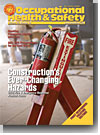
December 2006
- Construction's Ever-Changing Hazards
- Handling Flammable Liquids with Care
- AED, CPR Preparedness for the Real World
- Safety Identification 101
Click here to subscribe.
Features
By Mike Kasun
WHEN I was younger, it used to frustrate me to hear folks talk of the "good old days." As with most of us, the frustration subsided as I got older. Comparing everything from the pace of life to the cost of gasoline, a clearer understanding of the "good old days" apparently comes with age!
By Ralph M. Shenefelt
THE typical response to sudden cardiac arrest is not the stuff of Hollywood movies or TV medical dramas. Rarely is the most-trained, clearest-thinking person on the scene first, taking charge and saving a life against long odds. Rarer still are bystanders who instantly become part of the solution instead of a distraction or impediment. Panic, confusion, fear, people getting in one another's way--now, that's often the real world.
By Brad Montgomery, Elroy Lundblad
AS a safety professional, you have learned how to quickly identify hazardous environments, led the effort in determining the best ways to protect your employees from those hazards, and spent countless hours training those same employees on everything related to safety. It's a safe bet you can probably recite an OSHA standard quicker than a quote from your favorite novel.
By Randy DeVaul
COMPLIANCE requirements for using and storing flammable liquids in the workplace are quite detailed and specific. Unfortunately, the requirements are spread over a number of agencies and multiple documents.
By Casey Hayes
NO one plans to be involved in an industrial accident, but it happens. In Al's case, it was simply a matter of being in the wrong place at the right time. While returning to his work area from the tool crib, a drum of caustic material slipped off a forklift. The drum hit the side of an inventory rack and split open. Al was splashed across his left side, soaking his clothing from head to toe. A significant amount of the hazardous material struck his exposed face and hands.
By Fred Elliott
CRUSHING, punctures, lacerations, sprains, and even aches and pains are common problems workers have with their feet. Footwear that doesn't match their hazard exposures are a leading reason for these, but overall workplace organization and work practices are often at fault.
By Glenn W. Laub, M.D., David Fritzsche
SUDDEN cardiac arrest (SCA) remains a significant cause of death in America's workplaces. OSHA attributes 13 percent of all workplace fatalities to SCA, and health experts estimate that more than 400,000 individuals die of SCA in the United States each year.
Departments
By Jerry Laws
I applaud the Federal Aviation Administration's FAA Safety Team (a/k/a the FAASTeam), which was rolled out Oct. 1, because it represents out-of-the-box thinking. Ask yourself this: When was the last time I spoke the words "safety" and "out of the box" in the same sentence? Too often, our industry watches the same trailing indicators, recycles old approaches, and spurns new technologies. Yet we insist we want better results.
By George Brogmus, Wayne Maynard
By Marc Barrera
You are Fire Capt. Johns. Your fire chief has just radio-relayed your orders. You ascend a ladder to the second floor, carrying more than 50 pounds of equipment with Probational Officer Ed in tow. You break open a locked window and enter a room that feels like a furnace. A smoke-filled, gloomy haze blankets the limited vision your respirator mask allows. How can you hope to locate the victims in this smoke and heat?